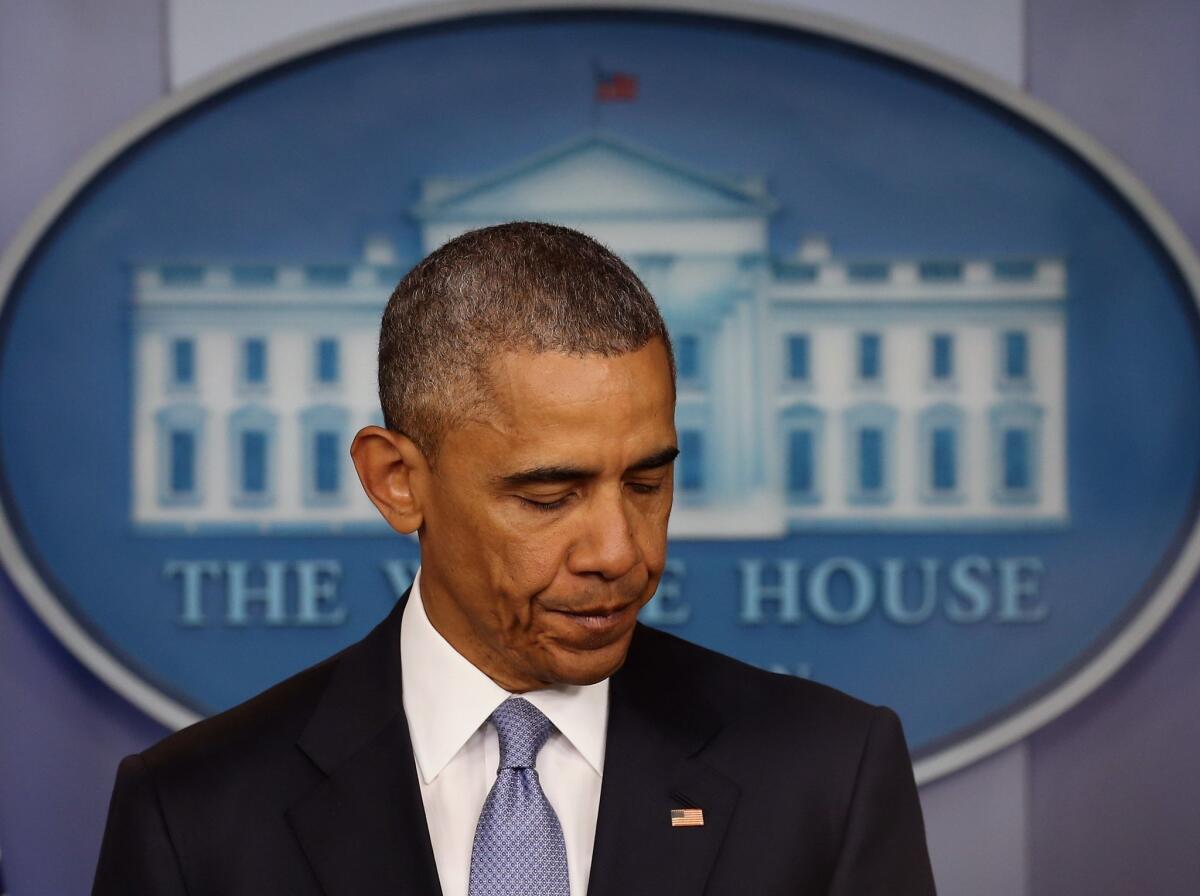Are we winning the drone war?

- Share via
Almost two years ago, President Obama announced that he was tightening the rules under which the CIA carries out drone strikes against suspected terrorists in Pakistan, Yemen and other countries. “Before any strike is taken, there must be a near-certainty that no civilians will be killed or injured — the highest standard we can set,” he said.
Afterward, civilian casualties did, in fact, fall significantly, according to independent monitoring groups. One of those groups, the Bureau of Investigative Journalism, says four civilian deaths have been reported in Pakistan in the 16 months since the end of 2013, down dramatically from a high of 197 in 2010.
But Obama’s higher standard wasn’t enough to avoid the unintended killing of two civilian hostages, one American and one Italian, in a Jan. 15 drone strike in Pakistan. As the White House acknowledged this week, the CIA didn’t know that Warren Weinstein and Giovanni Lo Porto were being held at the target site.
Nor did the new rules protect two other U.S. citizens who had joined Al Qaeda from being killed the same week, even though they weren’t specifically targeted for elimination. If they had been targeted, the two Americans’ cases would have received high-level review — another Obama reform. But the CIA didn’t know that Adam Gadahn and Ahmed Farouq were in its crosshairs, because those strikes weren’t aimed at specific individuals; they were aimed at sites where suspicious activity was going on. The CIA calls these “signature strikes,” because they’re based on troubling patterns that would seem to indicate Al Qaeda’s presence.
Most of the time, “the United States simply does not know who it is killing,” says Micah Zenko of the Council on Foreign Relations.
If that makes you feel a bit queasy, you’re not alone. In 2013, Obama aides said the president wanted to phase out signature strikes — but that hasn’t happened. In both Pakistan and Yemen, U.S. drones are still shooting at suspected Al Qaeda members without knowing exactly who they are.
And that isn’t the only problem with our mostly invisible drone war, which is now in its eighth year. We don’t even know whether we’re winning.
“Our actions should meet a simple test: We must not create more enemies than we take off the battlefield,” Obama said in another of his drone-reform speeches, this one in 2014.
When the drone wars began, back in 2008, Al Qaeda’s active membership was estimated at roughly 300, mostly in Pakistan and Afghanistan. Drone strikes succeeded in reducing that number and making “Al Qaeda Central” largely ineffective.
But the group’s offshoots have burgeoned. The most dangerous, based in Yemen, has grown to more than 1,000 members, even though it has been the target of a sustained U.S. drone campaign for six years.
Worse, the drone wars have made us other enemies. As recently as last year, Obama described Yemen as a success story, because the government of Abdu Rabu Mansour Hadi enthusiastically supported U.S. counter-terrorism efforts.
But other Yemenis disliked seeing their country turned into a target range for foreign military forces. The Houthi rebels who toppled Hadi in January cited his alliance with the United States as one of their complaints — even though they, too, have been fighting Al Qaeda.
As a result of the ensuing civil war, U.S. bases in Yemen have been evacuated and U.S. intelligence efforts have been disrupted. The drone strikes against Al Qaeda have continued, officials say, but they’ve been less effective than before.
Nevertheless, CIA Director John O. Brennan said this month at a Harvard event that he thinks the war on terrorism is succeeding overall, that the world would look even worse without a major counter-terrorism campaign that included drone strikes. “We would be facing a horrendous, horrendous environment,” he said.
When it comes to Al Qaeda’s ability to launch another 9/11 style attack against the United States, he’s surely right. But when it comes to the larger phenomenon of militant groups spreading from Islamic State in Iraq and Syria to Boko Haram in Nigeria, the evidence of success is far less clear.
There’s a lot to like about lethal drones — as long as you’re the owner, not the target, of course. They’re precise; they’re agile; they’re less costly than many of the alternatives, including manned bombers and boots on the ground.
But, too often, the drone strikes themselves “seem to be the strategy, rather than a tactic used within a larger strategy,” said Rachel Stohl, director of a task force on drone policy for the nonpartisan Stimson Center.
Obama said last week that he’s ordered a review of the January strike, but it’s going to be narrowly focused, aimed at determining why the CIA didn’t know that two civilian hostages were present at a target site.
What the Obama administration really needs, though, is something it hasn’t done for at least two years: a top-to-bottom review of its drone policies — focused not only on targeting rules, but also on costs and benefits. We need a public answer, complete with real evidence, to the president’s own question: Are we creating more enemies than we take off the battlefield?
doyle.mcmanus@latimes.com
Twitter: @doylemcmanus
Follow the Opinion section on Twitter @latimesopinion and Facebook
More to Read
A cure for the common opinion
Get thought-provoking perspectives with our weekly newsletter.
You may occasionally receive promotional content from the Los Angeles Times.







